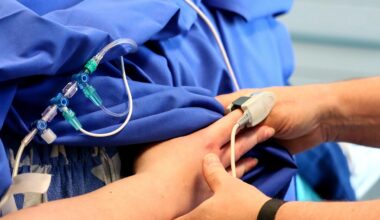Resistance Training Frequency for Golf Performance Gains
In the world of competitive golf, the physical demands are immense, highlighting the critical nature of fitness. To maximize performance, players must integrate resistance training into their workout routines. This type of training focuses on building muscular strength and endurance, which are essential for executing powerful swings and maintaining stability during the game. The frequency of resistance training sessions is vital since it influences both muscle growth and recovery rates. Golf players aiming for enhanced performance should aim for at least two to three resistance training sessions per week. These sessions can focus on different muscle groups while providing a balanced approach to overall strength. Moreover, a varied training schedule can prevent injury and increase motivation. Considering that consistency plays a key role in fitness gains, sticking to a routine tailored to each player’s needs can foster significant improvements in performance over time. Players should consult with fitness professionals to create a specialized program that addresses their strengths and weaknesses, ensuring effective use of their training time. Regular assessment of one’s progress and training diary can help keep motivation alive and goals achievable throughout the season.
Incorporating resistance training into your golf routine not only promotes overall strength but also fosters better posture and flexibility. The rotational nature of a golf swing demands a strong core, as it aids in transferring energy from the lower body to the upper body efficiently. Establishing a structured plan that includes resistance exercises aimed at the core can enhance swing power, improve balance, and ultimately translate into lower scores on the golf course. Research indicates that players who have a reliable strength training regimen see increases in their driving distance and accuracy, key factors in competitive play. Golfers should include a mix of free weights, machine exercises, and body-weight movements. These can include squats, deadlifts, and rotational medicine ball throws, all of which target muscles essential for golf performance. However, the primary goal must be to improve functional strength, enabling players to execute their swings optimally. Additionally, monitoring progress regularly through fitness assessments can help players identify areas needing improvement. Emphasizing strength gains while ensuring proper form during all exercises will result in a safer and more efficient training routine.
The Importance of Recovery in Resistance Training
Recovery is a crucial aspect of any training program, including resistance training for golfers. Engaging in frequent high-intensity workouts without sufficient recovery can lead to fatigue and diminished performance levels. Therefore, it is imperative that golfers include recovery days in their schedule, allowing muscles to heal and prevent injuries. The body requires time to repair microtears in muscle fibers, which occur during intense training sessions. Incorporating active recovery techniques, such as light stretching or yoga, can aid muscle recovery and enhance flexibility. Nutrition also plays a vital role in recovery; consuming protein-rich foods after workouts helps rebuild muscle. Hydration cannot be overlooked either, as it maintains performance and recovery. Players should also prioritize sleep as part of their recovery process, since quality sleep supports muscle repair and overall health. Ultimately, balancing resistance training with adequate recovery is essential for sustained improvement in performance. Golfers with a well-rounded regimen that aligns training and recovery practices will likely find themselves excelling in competitive scenarios, leading to improved scores and greater enjoyment of the sport.
Beyond strength training, balance and agility exercises should also feature prominently in a golfer’s fitness regimen. These elements are essential for providing the stability needed during swings and navigating uneven terrains on the golf course. Incorporating exercises such as single-leg balances, plyometric movements, and agility drills can significantly enhance a golfer’s ability to perform. Not only do these activities maintain balance, but they also promote overall functional stability, which is crucial for a powerful golf swing. Golfers should consider integrating activities that mimic the demands of the game while ensuring a strong focus on coordination and footwork. Furthermore, agility training can enhance reaction times, something crucial for competitive play. A comprehensive training program that addresses these various aspects will prepare golfers to perform optimally during tournaments. Players should periodically reassess their routines for continued effectiveness. As athletes develop, adapting exercise intensity and complexity will ensure sustained growth and performance improvements. Establishing a multi-faceted fitness routine will not only enhance one’s physical capabilities but also contribute to a greater enjoyment of the sport.
Customization of Training Programs
Every golfer’s fitness journey is unique, which is why customizing a training program to fit individual needs is paramount. Each athlete possesses different strengths, weaknesses, and goals, necessitating individualized plans that promote optimal growth. Factors such as age, current fitness level, and specific performance goals can guide the creation of a personalized program. Involving a professional trainer with experience in golf fitness can provide insights into areas requiring focus. A tailored program might incorporate resistance training, flexibility routines, and cardiovascular conditioning while accommodating the golfer’s schedule. Additionally, with regular assessments, adjustments can be made to ensure progress remains aligned with the player’s aspirations. Golfers should prioritize exercises that target the muscles utilized during the swing, emphasizing the core, legs, and upper body. Combining various training modalities will foster well-rounded development that enhances performance on the course. Connecting with fellow golfers for support and motivation can also enhance compliance to the program. Overall, understanding that each player is different will pave the way for a successful and fulfilling fitness journey.
Maintaining motivation throughout a resistance training program is vital for golfers aiming for success. While the path toward improvement can sometimes be challenging and monotonous, strategies can help sustain enthusiasm over time. Setting short-term, achievable goals can foster an ongoing sense of accomplishment, keeping motivation high. Engaging in training with friends or fellow golfers can foster camaraderie and create a more enjoyable experience. Exploring new training styles and incorporating varied exercises can also break the routine. Challenge, novelty, and excitement can rejuvenate one’s approach to fitness, making training feel less like a chore. Furthermore, tracking progress can highlight areas of improvement, reinforcing the value of consistent efforts. Techniques like journaling and sharing progress with others can enhance accountability, encouraging commitment to the routine. Celebrating milestones, no matter how small, can provide a sense of fulfillment and motivate continued hard work. Ultimately, a positive mindset coupled with structured approaches to goal setting will lead to greater fitness results and lower scores on the course. Investing time in both mental and physical aspects is essential for long-term success.
Conclusion on Resistance Training for Golf
In summary, resistance training frequency significantly impacts golf performance. Players must focus on developing strength, flexibility, and vital physical abilities through persistent and well-structured training regimens. Including exercises tailored to the demands of golf will create strength in crucial areas while enhancing overall stability. Emphasizing recovery, customization, and motivation plays a critical role in sustaining progress. By maintaining a balanced approach to training, players can see remarkable improvements in their performance. This holistic regimen, emphasizing physical fitness and mental fortitude, enables golfers to tackle the challenges of competitive play with renewed confidence. In addition, golfers can engage coaches and trainers to maximize their training efforts. Loving the game of golf means embracing all aspects: technique, mental resilience, and fitness. By putting in the necessary effort in resistance training and maintaining an unwavering focus on fitness, players are not just preparing for better scores but also ensuring longevity in their beloved sport. Thus, the journey toward improved golf performance starts with a solid commitment to enhancing physical fitness through resistance training.
Competitive golfers aiming to improve their performance must understand the importance of a comprehensive training regimen integrating resistance activities. The balance between training intensity, recovery, and technique development will create a promising trajectory for continuous improvement. The application of resistance training is not about simply lifting weights but about leveraging physical strength to achieve peak golf performance. Golfers must embrace these practices as essential parts of their overall game, allowing them to perform consistently at higher levels. Ultimately, the commitment to physical fitness, when aligned with skill development, will yield rewarding results on and off the course.


